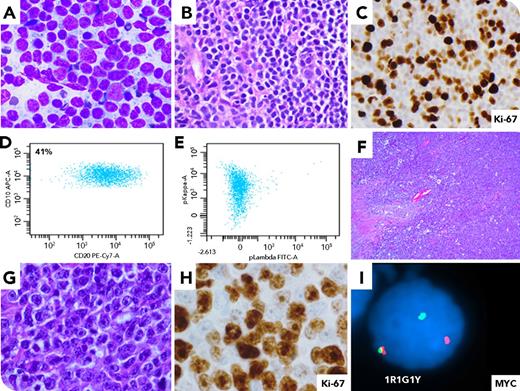A 66-year-old man with follicular lymphoma after multiple therapies presented with a retroperitoneal mass (panel A: fine needle aspirate, Diff-Quik stain, 1000× oil immersion; panels B-C: needle biopsy, hematoxylin and eosin (H&E) and Ki-67 stains, 500× oil immersion) compatible with his history of follicular lymphoma. Limited biopsy precluded grading and Ki-67 staining was 40%. Flow cytometry showed a κ-restricted, CD10-positive mature B-cell population (panels D-E), and he was treated with chemoradiotherapy. Five years later, he presented with a testicular mass and orchiectomy showed germinal center type, Epstein-Barr virus–encoded small nuclear RNA in situ hybridization–negative, diffuse large B-cell lymphoma with “starry sky pattern” (panels F-G: H&E stain, 100× and 1000× oil immersion), focal necrosis, and lymphoma at the spermatic cord margin. Proliferation index was 60% to 70% (panel H: Ki-67 stain, 1000× oil immersion). Fluorescence in situ hybridization confirmed MYC rearrangement (panel I; 77% of nuclei examined), IGH/BCL2 (31% of nuclei examined), and IGH gain (19.5% of nuclei examined) but no BCL6 rearrangement.
The presence of large atypical cells in follicular lymphomas has been associated with early large cell transformation. T-cell–mediated immunosurveillance and chemotherapy are thought to have reduced efficacy in immune-privileged sites, where transformation to aggressive variants like blastoid or double-hit large B-cell lymphomas may be more likely.
A 66-year-old man with follicular lymphoma after multiple therapies presented with a retroperitoneal mass (panel A: fine needle aspirate, Diff-Quik stain, 1000× oil immersion; panels B-C: needle biopsy, hematoxylin and eosin (H&E) and Ki-67 stains, 500× oil immersion) compatible with his history of follicular lymphoma. Limited biopsy precluded grading and Ki-67 staining was 40%. Flow cytometry showed a κ-restricted, CD10-positive mature B-cell population (panels D-E), and he was treated with chemoradiotherapy. Five years later, he presented with a testicular mass and orchiectomy showed germinal center type, Epstein-Barr virus–encoded small nuclear RNA in situ hybridization–negative, diffuse large B-cell lymphoma with “starry sky pattern” (panels F-G: H&E stain, 100× and 1000× oil immersion), focal necrosis, and lymphoma at the spermatic cord margin. Proliferation index was 60% to 70% (panel H: Ki-67 stain, 1000× oil immersion). Fluorescence in situ hybridization confirmed MYC rearrangement (panel I; 77% of nuclei examined), IGH/BCL2 (31% of nuclei examined), and IGH gain (19.5% of nuclei examined) but no BCL6 rearrangement.
The presence of large atypical cells in follicular lymphomas has been associated with early large cell transformation. T-cell–mediated immunosurveillance and chemotherapy are thought to have reduced efficacy in immune-privileged sites, where transformation to aggressive variants like blastoid or double-hit large B-cell lymphomas may be more likely.
For additional images, visit the ASH Image Bank, a reference and teaching tool that is continually updated with new atlas and case study images. For more information, visit http://imagebank.hematology.org.


This feature is available to Subscribers Only
Sign In or Create an Account Close Modal